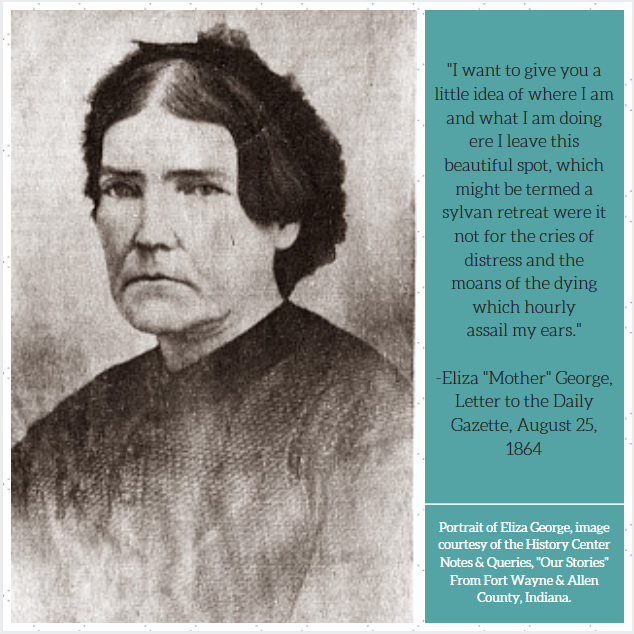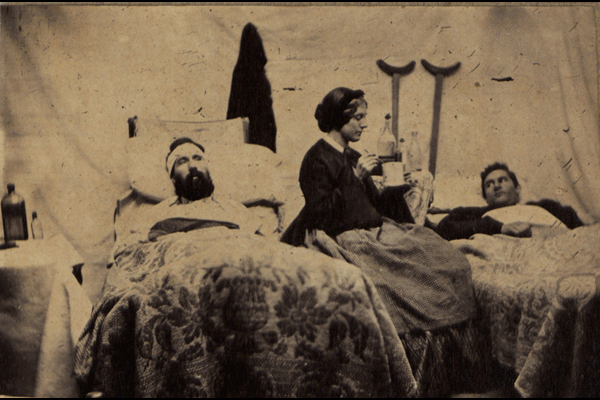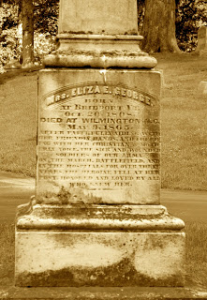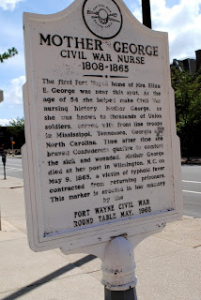This post was adapted from a February 2007 article in Fort Wayne Magazine “Along the Heritage Trail with Tom Castaldi.”

Some of us recall Decoration Day, when we tended the graves of soldiers, sailors, and our families’ burial places. The holiday was established to honor the nation’s Civil War dead by decorating their graves. It was first widely observed on May 30, 1868, by proclamation of General John A. Logan of the Grand Army of the Republic. On May 5th of that year, Logan declared in General Order No. 11 that, among other directives, the 30th of May, 1868, was to be designated for the purpose of strewing with flowers the graves of comrades who died in defense of their country during the late rebellion.
Indiana’s Eliza Hamilton George was among those lost in the Civil War. Born in Bridgeport, Vermont, in 1808, she married W. L. George before coming to Fort Wayne, Indiana sometime prior to 1850. In that year, one of her daughters, also named Eliza, married another young newcomer to the city, Sion Bass, who had arrived from Kentucky in 1849. Sion Bass joined the army in 1861 at the outbreak of the Civil War and helped to organize the 30th Regiment of Indiana Volunteers; he was chosen to be its first commander. At the battle of Shiloh in April 1862, Sion was killed leading a charge of his regiment against Confederate lines.

The loss of Eliza’s son-in-law and the news of the terrible suffering of Union soldiers everywhere made a great impression on Mrs. George. Early in 1863, at 54 years of age, she applied for duty in the Sanitary Commission, the forerunner of the Army Nurse Corps. Her value as a nurse was quickly realized in the rapidly overflowing hospitals in Memphis, her first duty station. Here she soon was commended enthusiastically by those for whom she worked, from the beleaguered doctors in the field to Indiana’s Governor Oliver P. Morton. Her special care of the soldiers caught the imagination of the Indiana press as well.
An Indianapolis newspaper, for example, told of the occasion she sat for twenty hours with a young frightened soldier, holding ice against his bleeding wound. Whenever she tried to have some one relieve her, the boy so painfully begged her to stay that, “she forgot her own weariness and applied the ice again.” When shells were falling in and around the hospital tent, she picked up the wounded and, one by one, in the face of enemy fire carried them in her arms to safety.
Eliza described her account of stepping off the hospital train in Kingston, Georgia, writing:
We arrived to witness one of the saddest sights I ever witnessed. An ambulance train brought in 1200 wounded men. A large number were slightly wounded or at least in hands and feet, and some with two fingers carried away, some through the hand, etc. There were 75 with amputated legs and arms some wounded in the head, in feet, in every form and manner.

Eliza also lamented the plight of women on the Civil War home front, writing on December 8, 1864:
The wind is whistling round the house, the cannon booming in the distance and my heart is aching for the houseless, homeless, destitute women whose husbands are in the Union Army, fighting for their country’s life. Oh, my children, turn your thoughts away from every vain and superficial wish, that you may have at least a mite to give to the needy. Suffering is no name to apply to the many I see destitute of home and place to lay their head. You know how like a cool draught of water to a thirsty soul, is a letter to me from home; and you know I would write if I could but my time is not my own.
Near the end of the war, “Mother” George – as she had come to be called affectionately by the soldiers – was assigned to the army hospital in Wilmington, North Carolina. There, at the same time, came nearly eleven thousand newly freed Union prisoners of war. Mother George gave herself completely to relieve the suffering of these men, but in an outbreak of typhoid among the troops, the exhausted Mother George contracted the disease and died on May 9, 1865, scarcely a month after the end of the war.
Her body was brought back to Fort Wayne where she was buried with full military honors in Lindenwood Cemetery, the only woman to have been so honored there. Later that same year, the Indiana Sanitary Commission and the Fort Wayne Ladies Aid erected a monument in her memory in the cemetery. A weathered granite shaft with the simple inscription on its face that reads, “Mrs. George” still stands in a triangular space near her actual grave site across the way in the Col. Sion S. Bass family plot. Additionally, in 1965 the Fort Wayne Civil War Round Table placed a marker near the site of her first home in Fort Wayne.


In 1971, Congress declared Memorial Day, commemorating all fallen men and women who served in the Armed Forces. This Memorial Day we will think of Mother George, who died unaware of her great fame or a legacy that placed her among the important women contributors of the Civil War.
Check out IHB’s markers commemorating Civil War hospitals and nurses. Learn how Indiana Civil War surgeon John Shaw Billings revolutionized medicine due, in part, to his field experience.
